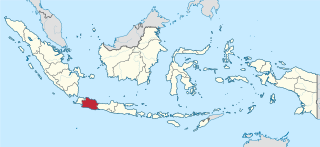
West Java is a province of Indonesia on the western part of the island of Java, with its provincial capital in Bandung. West Java is bordered by the province of Banten and the country's capital region of Jakarta to the west, the Java Sea to the north, the province of Central Java to the east and the Indian Ocean to the south. With Banten, this province is the native homeland of the Sundanese people, the second-largest ethnic group in Indonesia.

The angklung is a musical instrument from the Sundanese people in Indonesia made of a varying number of bamboo tubes attached to a bamboo frame. The tubes are carved to have a resonant pitch when struck and are tuned to octaves, similar to Western handbells. The base of the frame is held in one hand, while the other hand shakes the instrument, causing a repeating note to sound. Each performer in an angklung ensemble is typically responsible for just one pitch, sounding their individual angklung at the appropriate times to produce complete melodies.

Baduy people are an indigenous Sundanese ethnic group native to the southeastern part of Banten, specifically Lebak Regency, Banten, Indonesia.
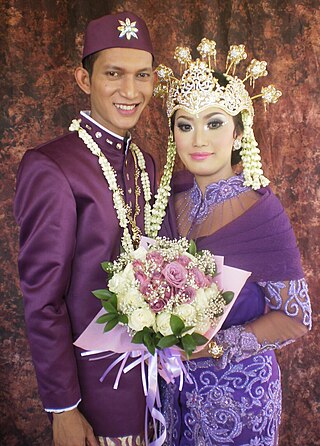
The Sunda or Sundanese are an indigenous ethnic group native to the western region of Java island in Indonesia, primarily West Java. They number approximately 42 million and form Indonesia's second most populous ethnic group. They speak the Sundanese language, which is part of the Austronesian languages.

The Cirebon or Cirebonese are an indigenous ethnic group native to Cirebon in the northeastern region of West Java, Indonesia. With a population of approximately 1.9 million, Cirebonese population, they are mainly adherents of Sunni Islam. Their native language is the Cirebonese, which is a form of mixed language between the Javanese and Sundanese, with a heavier influence from Javanese.
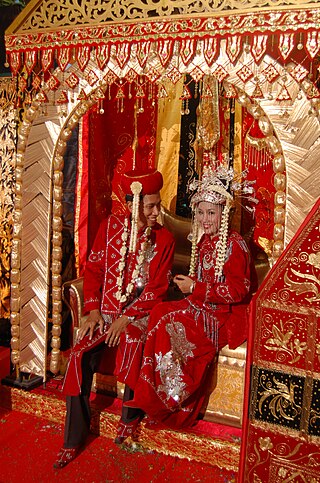
Betawi people, or Batavians, are an Austronesian ethnic group native to the city of Jakarta and its immediate outskirts, as such often described as the native inhabitants of the city. They are the descendants of the people who inhabited Batavia from the 17th century onwards.
In Indonesia, village or subdistrict is the fourth-level subdivision and the smallest administrative division of Indonesia below a district, regency/city, and province. Similar administrative divisions outside of Indonesia include barangays in the Philippines, Muban in Thailand, civil townships and incorporated municipalities in the United States and Canada, communes in France and Vietnam, dehestan in Iran, hromada in Ukraine, Gemeinden in Germany, comuni in Italy, or municipios in Spain. The UK equivalent are civil parishes in England and communities in Wales. There are a number of names and types for villages in Indonesia, with desa being the most frequently used for regencies, and kelurahan for cities or for those communities within regencies which have town characteristics. According to the 2019 report by the Ministry of Home Affairs, there are 8,488 urban villages and 74,953 rural villages in Indonesia. North Aceh Regency contained the highest number of rural villages (852) amongst all of the regencies of Indonesia, followed by Pidie Regency with 730 rural villages and Bireuen Regency with 609 rural villages. Prabumulih, with only 12 rural villages, contained the fewest. Counted together, the sixteen regencies of Indonesia containing the most rural villages—namely, North Aceh (852), Pidie (730), Bireuen (609), Aceh Besar (604), Tolikara (541), East Aceh (513), Yahukimo (510), Purworejo (469), Lamongan (462), South Nias (459), Kebumen (449), Garut (421), Bojonegoro (419), Bogor (416), Cirebon (412), and Pati (401)—contain one-third of all the rural villages in Indonesia. Five of these are located in Aceh, two in Highland Papua, three in Central Java, two in East Java, three in West Java, and one in North Sumatra. An average number of rural villages in the regencies and 15 cities of Indonesia is 172 villages. A village is the lowest administrative division in Indonesia, and it is the lowest of the four levels. A village is usually divided into a number of hamlets, and there are 252,315 hamlets in Indonesia.

Sukabumi Regency is a regency (kabupaten) in southwestern Java, as part of West Java province of Indonesia. The regency seat is located in Palabuhan Ratu, a coastal district facing the Indian Ocean. The regency fully encircles the administratively separated city of Sukabumi. Covering an area of 4,145.70 km2, the regency is the largest regency in West Java and the second largest regency on Java after the Banyuwangi Regency in East Java. The regency had a population of 2,341,409 at the 2010 census and 2,725,450 at the 2020 census; the official estimate as at mid 2022 was 2,806,664, with a large part of it living in the northeastern part of the regency that encircles Sukabumi City, south of Mount Gede. A plan to create a new regency, the North Sukabumi Regency is currently waiting for the approval of the central government.
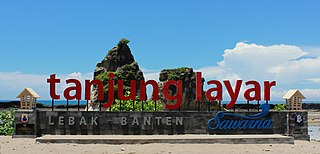
Lebak Regency is a regency of Banten province, Indonesia. It is located on the island of Java. The regency has an area of 3,305.072 km2 and had a population of 1,204,095 at the 2010 census and 1,386,793 at the 2020 census; the official estimate as at mid 2022 was 1,433,853. The town of Rangkasbitung in the north of the regency is the administrative centre. The regency is bordered by Pandeglang Regency to the west, Serang Regency to the north, and Tangerang Regency to the north-east, and by Bogor Regency and Sukabumi Regency of West Java Province to the east.

Mount Salak is an eroded volcano in West Java, Indonesia. It has several satellite cones on its southeast flank and the northern foot, along with two additional craters at the summit. Mount Salak has been evaluated for geothermal power development. According to a popular belief, the name "Salak" is derived from salak, a tropical fruit with scaly skin; however, according to Sundanese tradition, the name was derived from the Sanskrit word Salaka which means "silver". Mount Salak can be translated to "Silver Mountain" or "Mount Silver".

The Kasepuhan Banten Kidul are a traditional Sundanese community of approximately 5,300 people, who live in the southern part of Gunung Halimun National Park, in the Indonesian province of West Java. Gunung Halimun National Park is located within the borders of the Sukabumi Regency, Bogor and southern Banten province. The Kasepuhan is called "Kasepuhan Banten Kidul", their main village is Ciptagelar in the Cisolok subdistrict (kecamatan) in the western part of the Sukabumi Regency. The current head of the community, Abah Ugih, inherited the position of leader when his father, Abah Anom, died at the age of 54.

Mount Halimun Salak National Park is a 400 km2 conservation area in the Indonesian province of West Java on the island of Java. Established in 1992, the park comprises two mountains, Mount Salak and Mount Halimun with an 11-kilometer forest corridor. It is located near the better known Mount Gede Pangrango National Park, but the national park should be accessed from Sukabumi, 2 hours drive to the administration post and then 2 hours drive again to Cikaniki post gate.
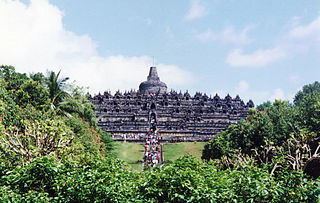
Sunda Wiwitan is a folk religion and ancient beliefs adhered to by the Sundanese in Indonesia.
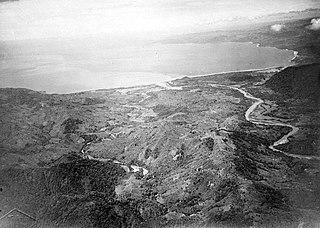
Mandiri River is a river in southwestern Java of West Java province, Indonesia. It flows mainly in the Sukabumi Regency.

Seren Taun is an annual traditional Sundanese rice harvest festival and ceremony. The festival was originally held to mark the new agriculture year in the Sundanese ancient calendar as well as thanks giving for the blessings of the abundance rice harvest, and also to pray for the next successful harvest. Seren Taun demonstrates the Sundanese agricultural way of life, and is held in high regard in Sundanese traditional villages, as the festival draw thousands Sundanese villagers to participate as well as Indonesian or foreign visitors.

Cangkuang temple is a small 8th-century Shivaist candi located in Kampung Pulo village, Cangkuang, Kecamatan Leles, Garut Regency, West Java, Indonesia. The temple is one of very few Hindu-Buddhist temples discovered in West Java, other temples include Batujaya and Bojongmenje temple.

Banten Sundanese or Bantenese is one of the Sundanese dialect spoken predominantly by the Bantenese —an indigenous ethnic group native to Banten— in the westernmost hemisphere of Java island, and in the western Bogor Regency, as well as the northwestern parts of Sukabumi Regency. A variety of Bantenese is spoken by the Ciptagelar people in the Kasepuhan Ciptagelar traditional community in the Cisolok district and the Kasepuhan Banten Kidul traditional community in the Lebak Regency.
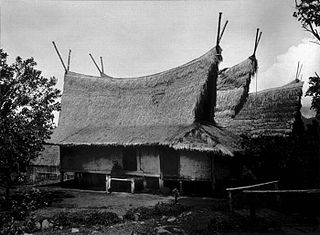
Sundanese traditional house refers to the traditional vernacular houses of the Sundanese people, who predominantly inhabited the western parts of Java island, Indonesia. The architecture of a Sundanese house is characterized by its functionality, simplicity, modesty, uniformity with a little detail, its use of natural thatched materials, and the quite faithful adherence to harmony with nature and the environment.
On afternoon 31 December 2018, a landslide struck a settlement in the village of Sirnaresmi in Sukabumi Regency, Indonesia, striking 30 houses and killing at least 18 people. The settlement, populated by around 100 people, was located in a landslide-prone area.

Pulosari is a village located in Kalapanunggal district of the Sukabumi regency in West Java, Indonesia



















